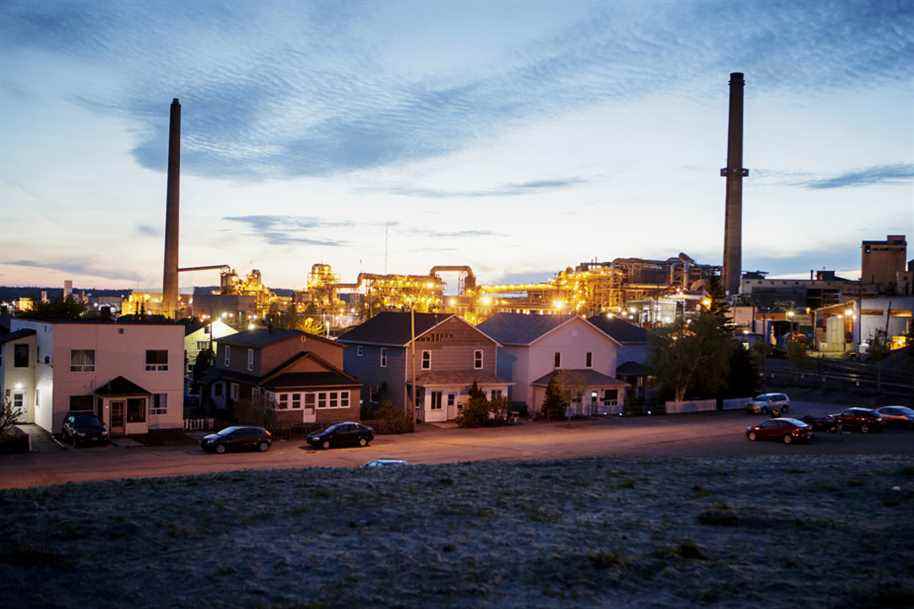Arsenic emissions from the Horne Foundry in Rouyn-Noranda increased in 2021 compared to 2020 and continue to greatly exceed the legal standard, Quebec government data shows.
Posted at 5:00 p.m.
The level of arsenic in the air measured at the sampling station of the Ministry of the Environment and the Fight against Climate Change (MELCC), located opposite the foundry, in the 6and Rue, averaged 100 nanograms per cubic meter (ng/m3) in 2021.
This is an increase from 2020, when emissions were 69 ng/m3according to the foundry, whose data come from the legal sampling station, located at the limits of its land – the two sampling stations are 4 meters apart.
A peak of 1170 ng/m3 of arsenic in the air was even recorded on January 22, 2021, at the 6and Rue, shows MELCC data, taken every three days.
Of 107 days measured in 2021, 39 exceeded the average of 69 ng/m3 of 2020.
The amount of arsenic in the air must not exceed 3 ng/m3according to the Quebec standard, which is also that of the World Health Organization – the foundry is however authorized to exceed it because this standard came into force in 2011, well after the start of its activities, in 1927.
The foundry blames the winds
The Horne Smelter calculates that its 2021 emissions averaged 87 ng/m3i.e. 26% more than the 69 ng/m3 of the previous year.
The company attributes the “slightly higher” result to a “greater proportion of winds to the legal sampling station,” it said in a statement released Thursday.
The Horne Foundry held a media briefing on Thursday, at which The Press was not invited and could not attend; the company also declined the interview request of The Press.
“Our representatives are not available,” Horne Foundry spokeswoman Cindy Caouette said in an email, saying only “local media” were invited to the briefing.
The comparison of the 2021 results to the average of the last five years shows a 30% reduction in the quantity of arsenic in the air measured at the legal station, she underlines, however refusing to disclose the data from this station. sampling, claiming that this information “is not of public order”.
The results presented today are encouraging, and we are satisfied with them.
Cindy Caouette, spokesperson for the Horne Foundry
Concerned Residents
Both the data from the Ministry and those from the Horne Foundry are of concern to the Rouyn-Noranda Committee to Stop Discharges and Toxic Emissions (ARET), which brings together parents and residents of the Notre-Dame district, which neighbors the company.
“We are very far from the norm,” exclaims Nicole Desgagnés, one of the group’s managers, calling for “actions that are effective for real” so that the reduction in emissions accelerates.
The emissions from the Horne Foundry demonstrate the ineffectiveness of its action plan to reduce them, approved by Quebec, estimates the ARET committee.
Parents of children are further concerned about emissions measured near the neighborhood school, which were 24 ng/m3 in 2021, show MELCC data, peaking at 230 ng/m3 June 15.
At 15 nanograms, research says you can have neurological damage in children.
Nicole Desgagnés, co-head of the Rouyn-Noranda Toxic Discharges and Emissions Stop Committee
Transparency demanded
The ARET committee is calling on the smelter to reduce the use of “complex concentrate,” ore with lower copper content, which contains more arsenic, and to be more transparent about its inputs.
“Perhaps their action was not effective last year, or perhaps it was effective, but they used more contaminated materials, launches Nicole Desgagnés, but you have to have the information to find out. »
The residents’ group laments that measurements of arsenic in the air are taken every three days and show a 24-hour average, for a pollutant whose amount in the air can fluctuate wildly from day to day. another, from one moment to another of the day.
He would also like more sampling stations, especially in areas of the city that do not have them.
The Minister of the Environment and the Fight Against Climate Change, Benoit Charette, said he was “obviously disappointed to see that emissions from the Horne smelter increased in 2021”, claiming to closely monitor the application of the plan. action of the company, according to a statement sent by his cabinet.
The worst measures of 2021
Amount of arsenic in the air at the 6 sampling stationand Street
- 1170ng/m3 – January 22
- 753ng/m3 – 1er April
- 668ng/m3 – March 14
- 517ng/m3 – June 15
- 475ng/m3 – February 3
Source: Quebec Ministry of the Environment and the Fight Against Climate Change

